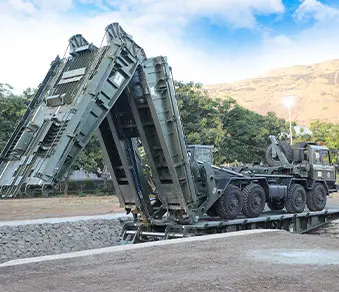Following a notable rally, defence stocks took a breather as investors opted to lock in profits. This comes after a period of significant gains bolstered by political stability and heightened government focus on the defence sector. Here’s a closer look at the key developments and what they mean for the market.
Key Defence Stocks Impacted
Bharat Dynamics: Shares declined by 5.6%, closing at ₹1,536 each. Similarly, Hindustan Aeronautics Limited (HAL) saw a decrease of 4.8%, while Bharat Electronics slipped by 3%. This trend was not confined to just these stocks; the broader defence sector experienced a wave of profit booking.
Other Defence Stocks Also Affected
The trend of profit booking extended to several other defence stocks, with declines ranging from 1% to 5.5%. This includes ideaForge Technology, Zen Technologies, Avantel, PTC Industries, Solar Industries India, Astra Microwave Products, MTAR Technologies, and Walchandnagar Industries. In contrast, Paras Defence managed to buck the trend, gaining 2% and trading at ₹1,437 per share.
The Rally’s Catalyst
Defence stocks had resumed an upward trend on June 5, 2024, after the BJP secured enough support to form a coalition government, ensuring continuity of economic policies and increased funding for the defence sector. Investors are optimistic about policy stability and the government’s ongoing economic reforms, particularly those focused on defence.
Government Initiatives and Budget Allocations
Over the past decade, the Indian government has implemented several measures to achieve self-reliance in defence manufacturing. The Defence Ministry aims for 70% self-sufficiency in weaponry by 2027, presenting significant opportunities for domestic manufacturers.
The ‘Atmanirbhar Bharat Programme‘ includes placing over 101 defence items under import embargo, promoting domestic production. Additionally, the government has set an ambitious target of US$ 6.02 billion in annual defence exports by 2028-29. The Defence Ministry’s budget for 2024-25 is US$ 74.8 billion, accounting for 13.04% of the total budget and marking a 4.72% increase from the previous year.
Market Prospects
These initiatives and budget allocations are poised to create substantial growth opportunities for domestic defence manufacturers, positioning them for increased market share both domestically and internationally. Despite the recent dip due to profit booking, the long-term outlook for defence stocks remains positive, supported by government policies and strategic investments.
HAL’s New CNC Machining Facility: Enhancing ISRO’s Capabilities
HAL recently unveiled a cutting-edge CNC Machining Facility, equipped with advanced machinery for fabricating rings and propellant tank domes for LVM3 rockets. This facility is set to significantly boost ISRO’s production capacity, especially for the Launch Vehicle Mark-3 (LVM3), India’s most powerful rocket.
Currently, ISRO manages only two LVM3 launches annually but requires six per year. HAL’s new facility will help meet this demand by producing essential components, thereby supporting an increase in annual LVM3 launches. ISRO Chairman highlighted HAL’s significant potential and its crucial role in addressing emerging technologies and design challenges. HAL’s continued partnership with ISRO will expedite human spaceflight missions and the development of Next-Generation Launch Vehicles (NGLV).
Recent Developments and Financial Health
During the inauguration ceremony, HAL handed over the first Gaganyaan Service Module and LVM3 YzU Isogrid Version Hardware to ISRO. As per the Bombay Stock Exchange (BSE), HAL’s market capitalization stands at Rs 3,15,996 crore.
Analyzing Hindustan Aeronautics Limited (NSE: HAL) Stock Performance
Despite an already impressive performance, HAL shares have continued to climb, gaining 35% in the last 30 days. This recent surge caps off a 221% increase over the past year. While half of Indian companies have price-to-earnings ratios (P/E) below 30x, HAL’s current P/E ratio of 46.3x stands out. This high P/E ratio suggests that investors are banking on continued robust earnings growth from HAL.
Earnings Growth and Market Sentiment
HAL has exhibited significant earnings growth, with a 31% increase in the last year and a 135% rise in EPS over the past three years. Analysts forecast a 9.7% annual earnings growth over the next three years, which is lower than the market’s predicted 21% growth per year. Despite this, the high P/E ratio indicates strong investor confidence in HAL’s future performance.
Does Growth Match the High P/E?
Hindustan Aeronautics Limited (HAL) has seen impressive earnings growth recently, with a 31% increase in the past year and a 135% rise over three years. Despite this, analysts predict a more modest 9.7% annual growth for the next three years, compared to the market’s expected 21%.
What Can We Learn From HAL’s High P/E?
HAL’s high P/E ratio suggests investors expect strong future earnings growth. However, analysts are less optimistic about HAL’s earnings potential matching these expectations. This disparity raises concerns about the sustainability of HAL’s current stock prices without substantial future earnings growth.
Market Sentiment vs. Analyst Projections
While investors remain optimistic, analysts are more cautious, predicting lower earnings growth compared to market expectations. This disparity suggests that the current optimism may not be sustainable unless HAL’s earnings growth improves significantly.
Here’s a table summarizing the Consolidated Equity and Liabilities as of March 31, 2024, and 2023:
| Particulars | As at 31-Mar-24 (₹ lakhs) | As at 31-Mar-23 (₹ lakhs) |
|---|---|---|
| Equity | ||
| Equity Share Capital | 33,439 | 33,439 |
| Other Equity | 28,80,378 | 23,23,776 |
| Non-Controlling Interest | 364 | 374 |
| Total Equity | 29,14,181 | 23,57,589 |
| Non-Current Liabilities | ||
| Financial Liabilities | ||
| – Borrowings | 10,15,841 | 10,15,151 |
| – Lease Liabilities | 102 | 151 |
| – Other Financial Liabilities | 3,50,580 | 2,84,503 |
| Provisions | 1,21,671 | 1,34,310 |
| Deferred Tax Liabilities (Net) | Unspecified | Unspecified |
| Other Non-Current Liabilities | 10,54,376 | 10,92,601 |
| Total Non-Current Liabilities | 12,62,904 | 12,80,064 |
| Current Liabilities | ||
| Financial Liabilities | ||
| – Borrowings | Unspecified | Unspecified |
| – Lease Liabilities | 0 | 14 |
| – Trade Payables | ||
| — Micro Enterprises & Small Enterprises | 14,605 | 6,407 |
| — Other than Micro & Small Enterprises | 4,26,682 | 3,07,090 |
| – Other Financial Liabilities | 2,45,138 | 2,10,943 |
| Other Current Liabilities | 22,54,968 | 18,53,714 |
| Provisions | 7,61,071 | 6,77,831 |
| Current Tax Liabilities (Net) | 29,967 | 26,728 |
| Total Current Liabilities | 36,32,433 | 30,82,727 |
| Total Equity and Liabilities | 78,09,518 | 67,20,380 |
This table organizes the equity and liabilities data clearly, making it easy to compare the figures between the two years.
Conclusion:
While recent profit booking caused temporary declines in defence stocks, the sector’s long-term outlook remains robust. Government initiatives and strategic advancements like HAL’s new CNC facility bolster confidence in future growth. Investors should navigate cautiously given HAL’s high P/E ratio, reflecting optimistic expectations amidst analysts’ more reserved forecasts. Yet, opportunities abound in India’s defence sector, driven by policies promoting self-reliance and expanding global exports. Balancing short-term market adjustments with these broader trends will be crucial for stakeholders eyeing sustained investment returns. For more company overview please click here
Disclaimer
Investing in stocks involves risks, including the loss of principal. The performance of Hindustan Aeronautics Limited, like any other company, is subject to various market conditions and economic factors. Potential investors should conduct their own research, consider their own financial situation and risk tolerance, and consult with a financial advisor before making investment decisions. Past performance is not indicative of future results. Invest at your own risk.




One thought on “Defence Stock Hindustan Aeronautics Limited (HAL) Experience Profit Booking Amid Market Adjustments in 2024”